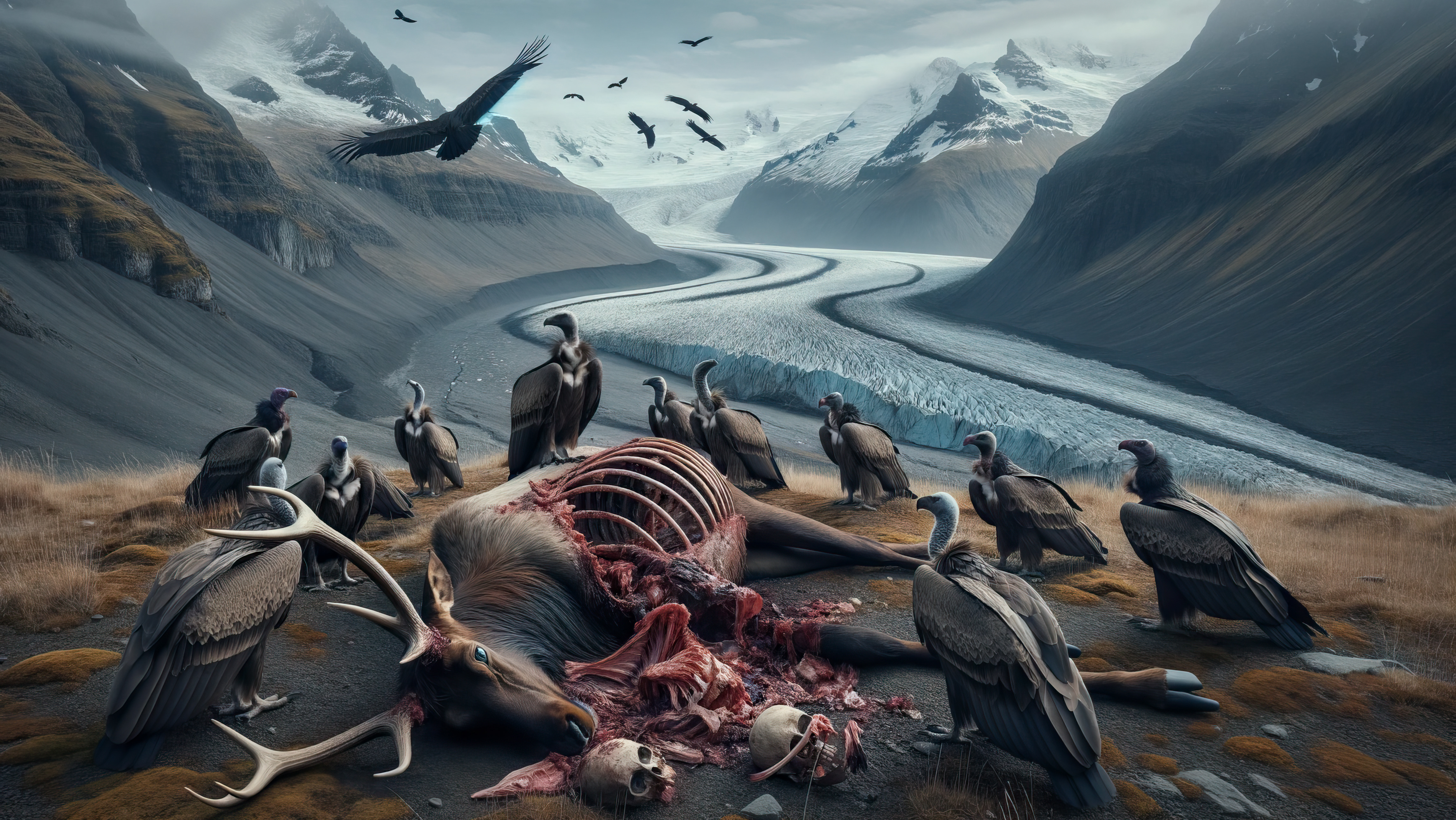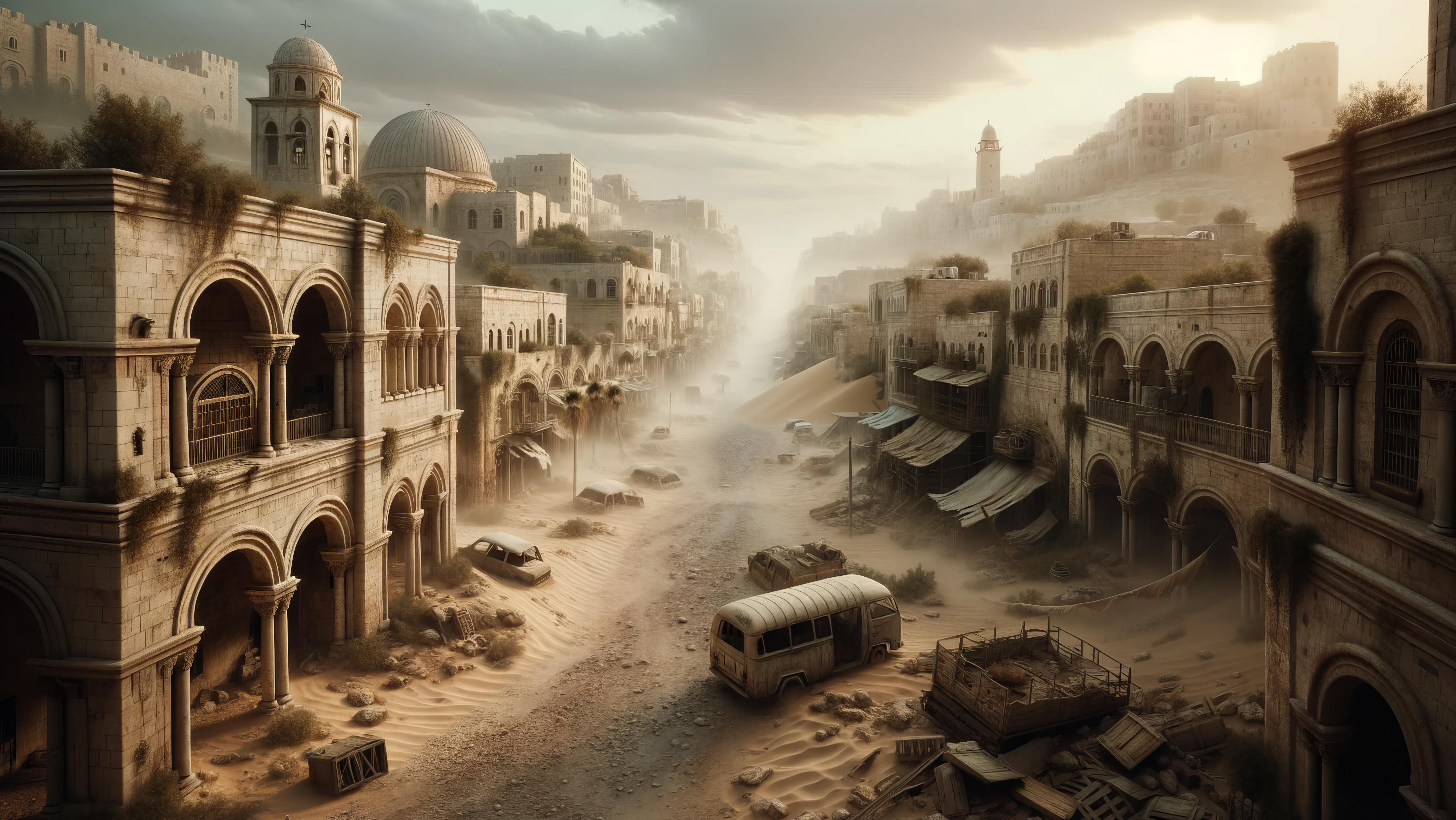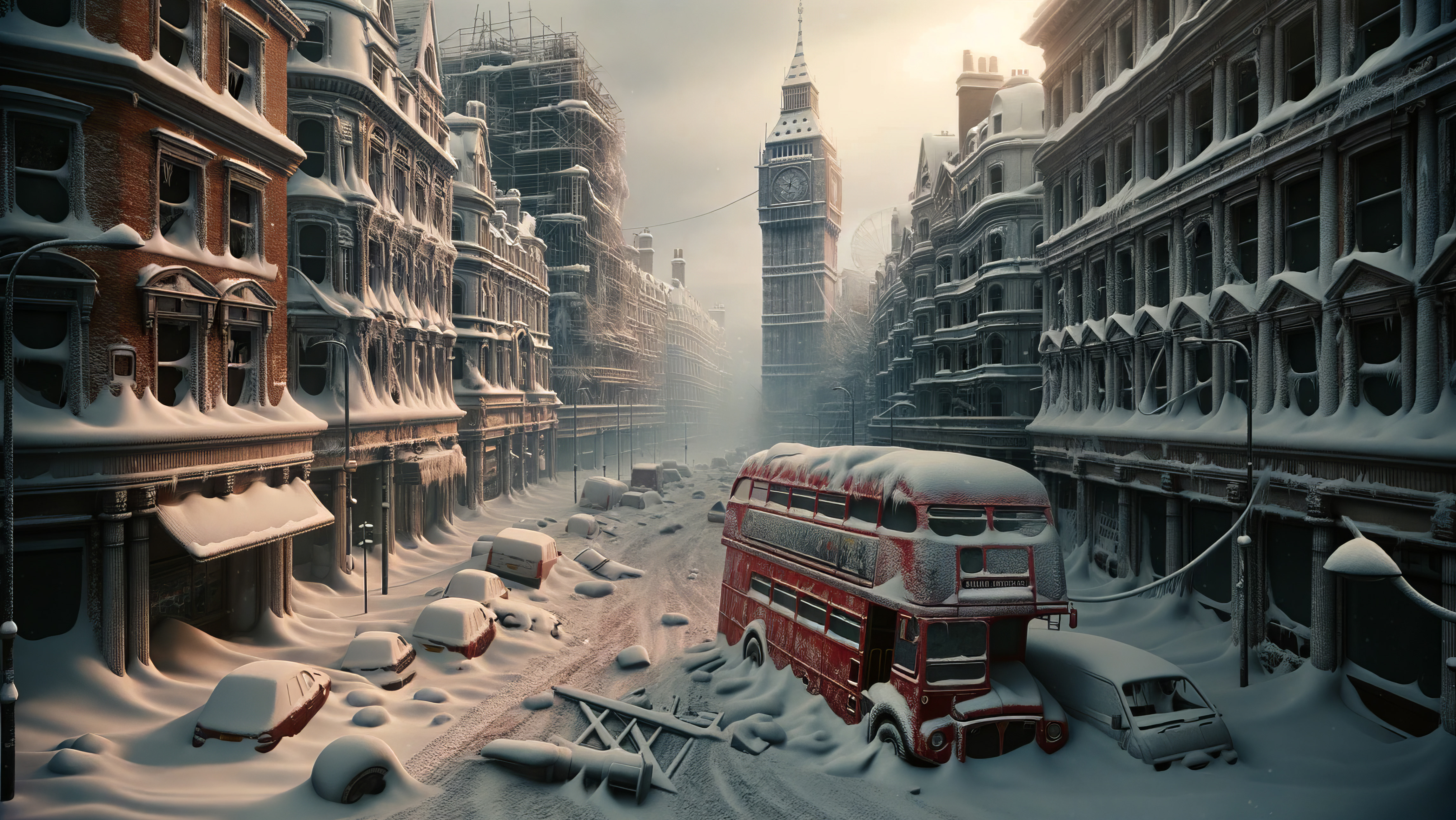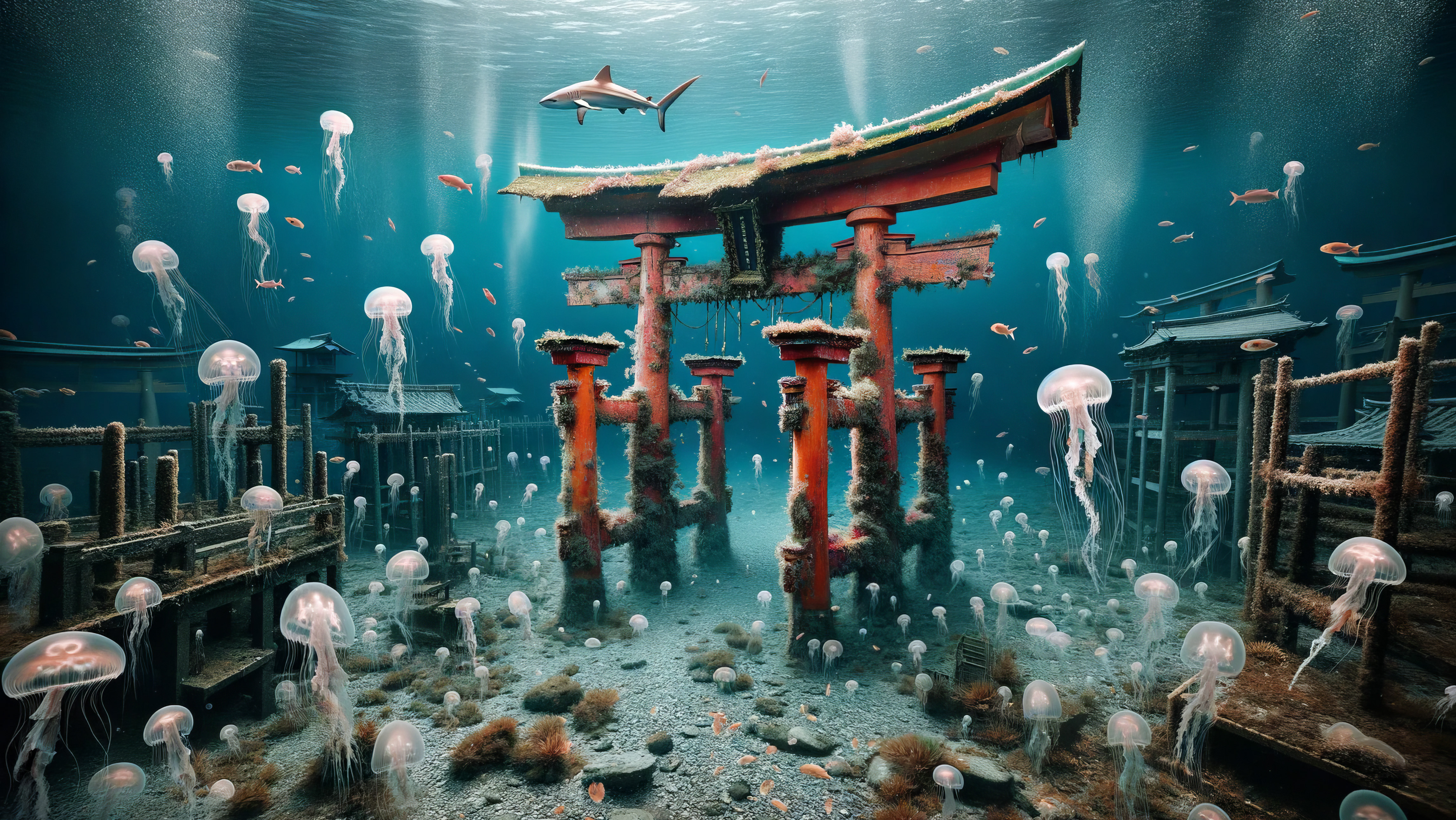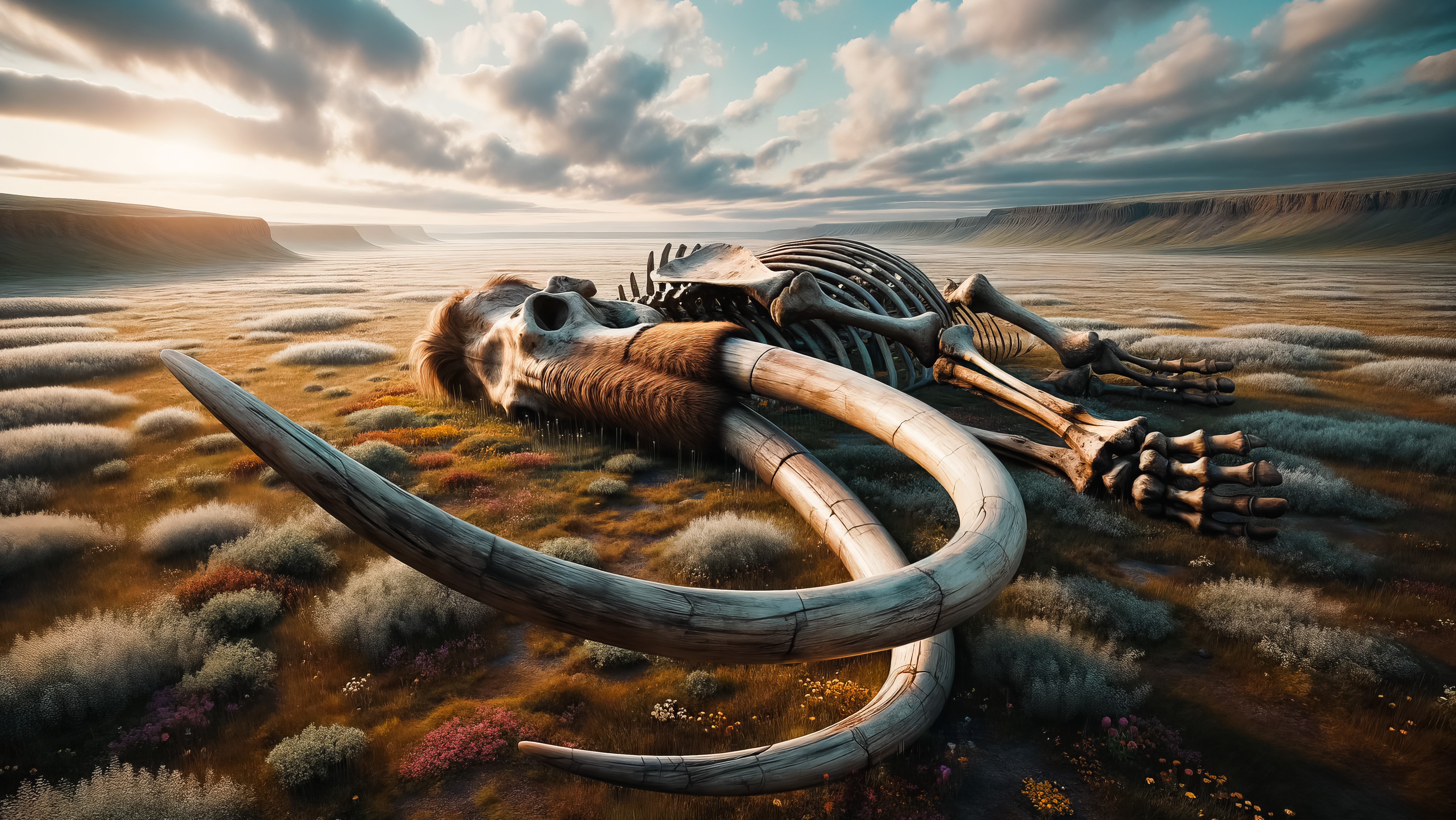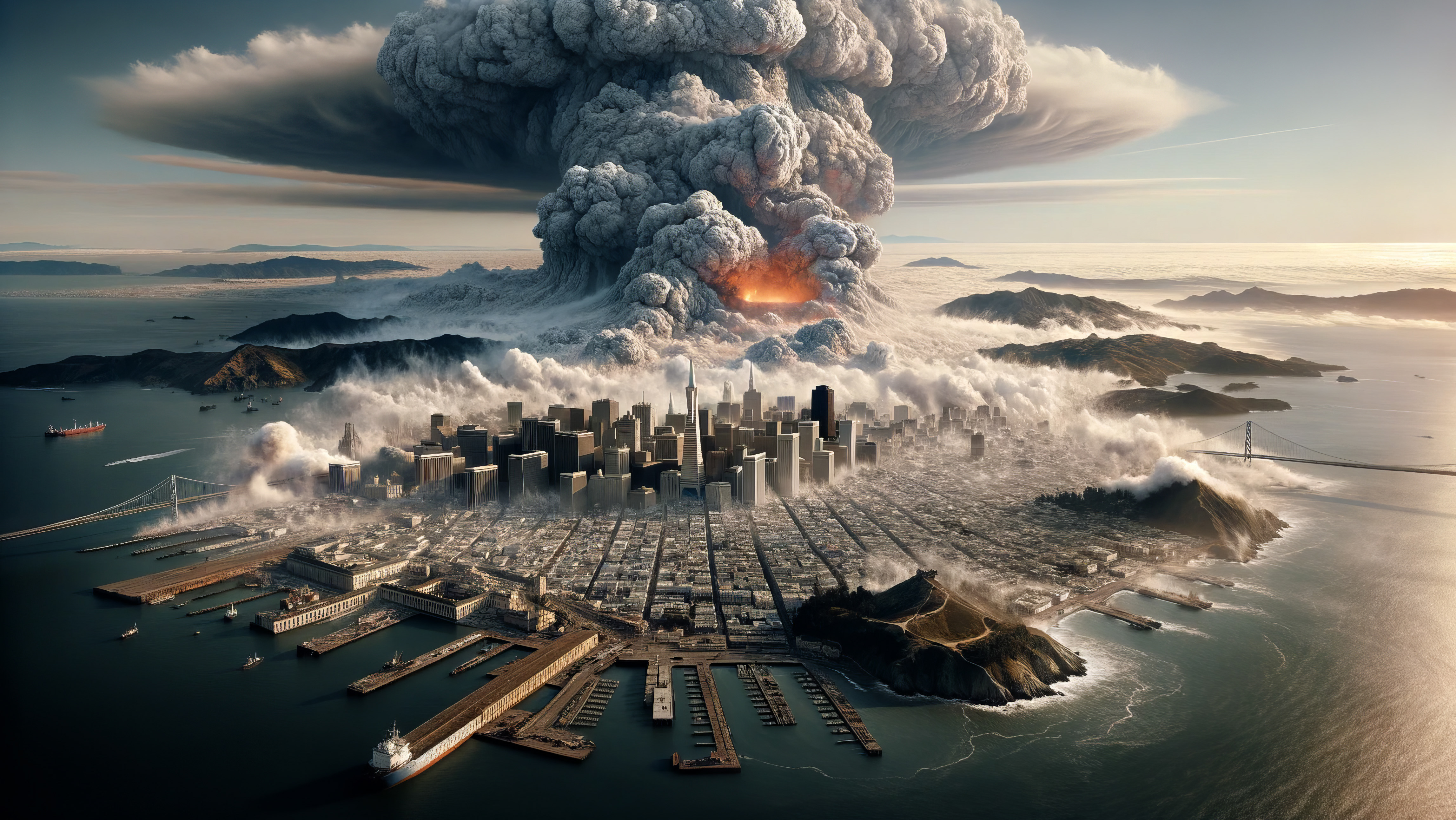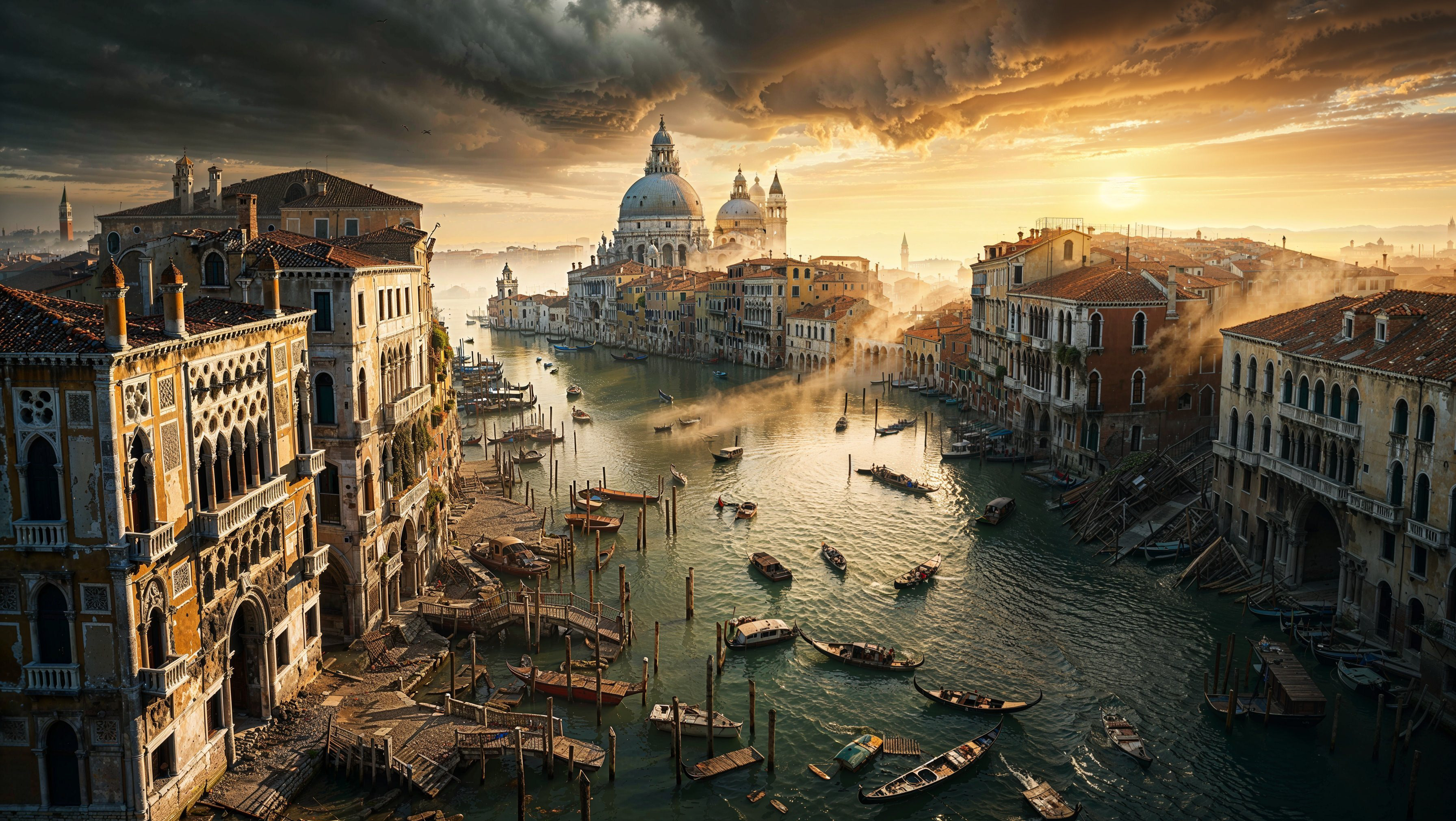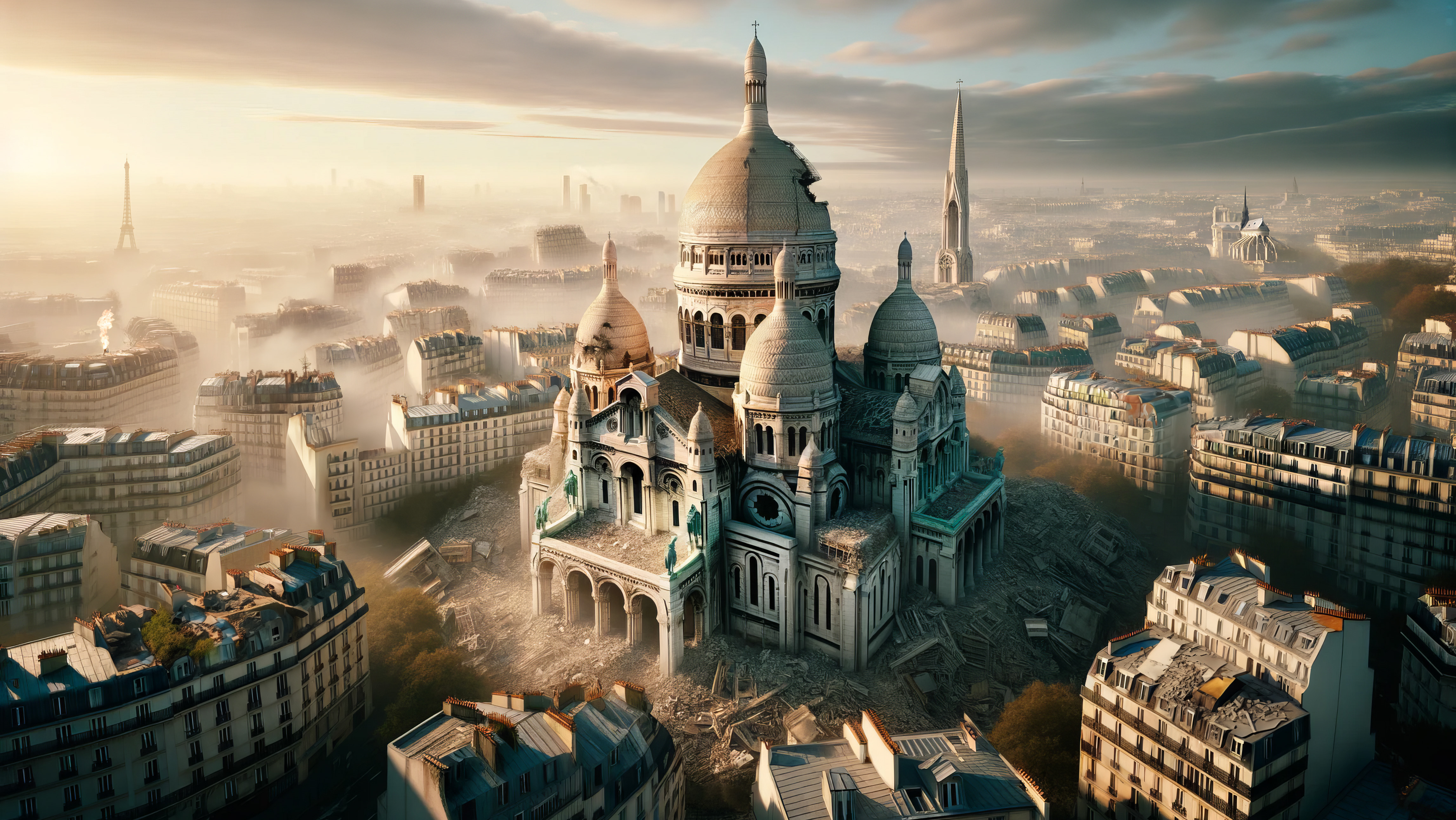Arrival at the Brooklyn Bridge
On a day marked by a sense of anticipation, my time travel journey brought me to July 5th, 2072, where I found myself standing before the remnants of the Brooklyn Bridge. A once-proud testament to human ingenuity, the bridge was now a poignant symbol of fragility and impermanence. Its cables snapped and hanging like defeated giants, were now pathways for animals.
Its gothic arches were shrouded in moss and vines, a bridge stretching not between boroughs but between epochs. The roadway was cracked and broken, yet it still stood, a defiant testament to the past power of human ingenuity.
The city's streets, filled with debris, twisted metal, shattered glass, and the lifeless bodies of yellow taxis, lay strewn like fallen soldiers in a lost battle. Cars were like drowned ants, once populating the bustling ant hill, now washed away. I found myself reflecting on the ephemeral nature of human civilization, feeling a profound sadness for the once-vibrant city that had been silenced by the force of an unforgiving wave. As I wandered through the paths now clogged with the remnants of humanity's ambition, I wondered about the strength and frailty of our constructs, and how quickly they could be undone.
In some places, the East River had flooded, transforming the bridge into a causeway. I walked along its length, feeling the weight of history beneath my feet. Every step seemed to echo with the memories of millions who had crossed this bridge, a river of humanity that had once flowed here.
Now, it was the domain of nature, a bridge that connected not just lands but times, a portal to a world that once was and never be again. The very essence of connection and movement had transformed into stillness and solitude. It was a profound paradox that stirred deep emotions within me, a reflection of the eternal dance between creation and decay, growth and dissolution.
As I walked along the bridges, the red chemicals mixing with the water on the streets reminded me of the complex dance of human progress and nature's wrath. The bridges were symbols of connection and separation, reminders of what had been lost.
Liberty Amidst Chaos – A Symbol in the Streets
As I ventured further into the desolate maze that was once New York, the surreal sight of the Statue of Liberty, strangely displaced and half-submerged in the middle of a street, stopped me in my tracks. Here was an icon of freedom and opportunity, now lying amidst the chaos, still holding her torch high but overgrown with vines and moss. The juxtaposition of strength and vulnerability was striking.
I spent hours observing the haunting image, pondering the symbolism of Liberty's torch and the nest of birds that had made it home. In the midst of destruction the area, now reclaimed by a dense forest, whispered of nature's power to erase, heal, and reclaim, even as it wipes away the marks of human civilization. In the forest's embrace, I sensed both a tragic loss and a soothing promise of renewal.
Times Square's Ghostly Glow – Echoes of Vibrance
The once-bustling Times Square lay silent and overgrown, a ghostly shadow of its former self. The iconic billboards, faded and torn, bore witness to a time when the square pulsated with energy and life. Now, the bioluminescent plants, casting an eerie glow where neon lights once dazzled, were nature's response to human creativity.
The silence of Times Square weighed heavily on my soul, yet I felt compelled to explore further, drawn by the melancholy beauty of decay. The rusted New Year's Eve Ball, once a symbol of joy and renewal, hung still in the silence, a rusted relic of times gone by.
The transformation was both mesmerizing and heartbreaking. Standing amidst the cracked and broken streets, I felt the passage of time and the relentless march of nature. A profound sense of loss mingled with awe at the persistence of life in the most unexpected places. Times Square's transformation was a metaphor for the cyclical nature of existence, a dance of creation and destruction that resonated deeply with my own reflections on the fleeting nature of all things.
Central Park – A Wild Sanctuary
Central Park, once a designed oasis amid concrete and steel, had transformed into a wild jungle. The city's towering skyscrapers, barely visible through the dense foliage, seemed to watch over the park with silent reverence. Bethesda Fountain, overrun by nature, had become a cascading spectacle of moss and vines, with water following its whimsical path. The Bow Bridge had evolved into a natural dam, its arches now a foundation for trees that reached out to the sky. The lake had become a marsh, teeming with wildlife, a thriving testament to nature's ability to create beauty from decay. I wandered through this living artwork, marvelling at the rich tapestry of life that had woven itself into the very heart of the city.
The wild beauty of Central Park was a poignant reminder of the inherent connection between urbanity and wilderness, a marriage of contrasts that now lay bare and unadorned. There was profound wisdom in the transformation, a lesson in humility and acceptance that resonated with my own journey through the ruins. In the wild embrace of the park, I found a sanctuary for contemplation, a space to reflect on the ephemeral dance of creation and dissolution.
The Empire State Building, its top floors collapsed, stood defiant against a stormy sky. Vines crawled up its sides, reaching towards the heavens as if to reclaim their place. From the distance, the building seemed untouched, but closer inspection revealed the truth: it was a skeleton, a hollow monument to a time long past. Its spire had become a roost for birds, the observation deck an overgrown garden in the sky. Standing at its base and looking up, I was struck by the majestic sadness of the building, a lone giant towering over the ruins. I found in its resilience a reflection of human determination, a will to endure even when broken.
One World Trade Center, its glass facade shattered, stood tall amidst the ruins. Its once sleek and reflective exterior now bore the scars of time and devastation. The surrounding reflecting pools had transformed into natural ponds, teeming with life, making a sharp contrast with the hollow silence of the shattered building. Its spire was broken, yet it remained the tallest structure around, a testament to resilience and remembrance. I stood before it, dwarfed by its magnificence, reflecting on the complex emotions it stirred within me. This building, a symbol of hope and recovery, was now part of a forest that had enveloped the city, becoming a monument in the wilderness.
The juxtaposition of the urban and the wild was a melancholy reminder of the impermanence of our creations. It spoke of a profound truth: that life finds a way, even in the most unexpected places. And yet, there was something tragic in this transformation, a loss that went beyond the physical. It was the silence of a dream unfulfilled, a promise broken, a city that once thrived now frozen in time. Rockefeller Center, its iconic ice-skating rink now a pond, had become a haven for wildlife. Where once laughter and music filled the air, now only the rustling of leaves and the soft calls of birds could be heard. The Christmas Tree, a symbol of joy and celebration, was now a giant pine, towering over the centre, its twinkling lights replaced by the glow of fireflies.
Walking through the centre, I was haunted by memories of stories from human books, of what had been and awed by the transformation that had occurred. It was as if the world had reclaimed what was once its own, turning artificial into the natural, the mundane into the mystical. There was wisdom in this transformation, a lesson in the cycles of life and death, creation and destruction. But there was also a poignant sadness, a mourning for a time that could never be again.
Grand Central Terminal – A Garden in the Ruins
Grand Central Terminal, once a bustling hub of human connection, now lay silent. Its celestial ceiling mural had become home to a colony of bats, the stars replaced by the fluttering of wings. The four-faced opal clock, a symbol of precision and order, was stopped, a testament to the passage of time. The main concourse was now a meadow, with wildflowers growing between the tracks. The iconic chandeliers had become nests for birds, and the terminal transformed into a garden in the ruins. The very essence of human movement and interaction had given way to a serene stillness, a tranquillity that seemed to whisper secrets of a time long gone. I wandered through the terminal, touched by its transformation, reflecting on the cycles of life that it now represented. The bustling energy had given way to a quiet beauty, a reminder that even in abandonment, there could be grace. The terminal had become a sanctuary, a place where the soul could rest and reflect on the impermanence of all things.
The Metropolitan Museum of Art stood with its grand steps now a cascade of greenery. Its iconic facade was weathered, yet still majestic, a noble remnant of a cultured past. Within its halls, galleries had become home to nature's own art, where once human expressions were celebrated. The sculptures in the garden were overgrown, assimilated into the landscape as if nature itself had crafted them. I stood before this cascade of beauty, touched by the poetry of transformation. Here, art and life had become one, and in this merger, a new form of beauty emerged. A quiet reflection on the impermanence of human creations settled within me. It was a melancholy realization that all things were crafted by human hands.
The Flatiron Building, with its unique triangular shape, stood as a silhouette against a fiery sunset, its structure now a verdant monument amidst the wilderness. Its windows were shattered, but its shape was still recognizable, a geometric wonder turned organic.
Standing before this once-proud edifice, I was struck by the juxtaposition of human achievement and nature's indomitable will. The building's towering form, now bereft of its original grandeur, was a reminder of the transient nature of all that is human-made. Yet it was not a desolate sight, for life had found a way to inhabit and rejuvenate this space.
I wandered through the forest surrounding the building, marvelling at the rich ecosystem that had taken root in a place once dominated by concrete and steel. A thought blossomed within me – even in human absence, life persists, adapts, and thrives. There was something comforting in that realization, a gentle assurance that our world, even when marred by destruction, still carried within it the seeds of renewal.
Rockefeller Center – A Sanctuary for Life
Rockefeller Center, once synonymous with entertainment and commerce, had transformed into a haven for wildlife. Its ice-skating rink was now a pond, reflecting the sky's ever-changing moods.
As I explored this new sanctuary, I couldn't help but be filled with a sense of awe at nature's ability to reclaim and transform. There was a serenity here, a peace that seemed to transcend the chaos of the past. The world had moved on, and in its wake, a new harmony had emerged, a delicate balance that spoke of wisdom far greater than our own.
The towering pine, standing in place of the Christmas Tree, seemed to symbolize the enduring spirit of life. It was not just a tree but a testament to the resilience and beauty of the natural world. In its branches, I found a lesson of hope and continuity, a gentle reminder that even in the face of great upheaval, life finds a way to flourish.
The City's Eternal Rest
New York, a city that once pulsated with unyielding energy, now lay in a state of eternal rest. As I wandered its streets, now reclaimed by nature and strewn with the debris of a bygone era, I was caught in a contemplation of existence itself. Buildings that once scraped the sky were reduced to skeletal remains, their interiors hollowed out, a stark reminder of the fragility of all we build. Streets once filled with the cacophony of human life were now silent, save for the soft rustle of leaves and the distant calls of birds.
As I navigated the red-tinged waters that flowed through the broken streets, a product of chemicals mixed with the residue of the disaster, I felt a growing sense of disconnection from the world I once knew from human books. It was as though I had stepped into a dreamscape, a place suspended between what was and what could be.
The Wisdom of Dissolution
The city's gradual dissolution was not a death but a transformation. The more I explored, the more I saw the wisdom in letting go, in allowing nature to take its course, and in accepting the cycles of creation and decay.
In some places, tropical plants had begun to overtake the concrete, turning streets into verdant pathways. Animals roamed freely, finding homes in the nooks and crannies of the fallen city. The air was filled with the scent of blooming flowers, a fragrance that spoke of life's enduring ability to create beauty from the ashes.
I realized that New York was not dying but transitioning into something new, something pure and essential, just not for humans any more. It was a meditation on existence, a lesson in humility, and a reminder that all things, no matter how grand or enduring they may seem, are subject to the inexorable flow of time.
As I prepared to leave this relic of a city, I found myself filled with a profound sense of peace. The city did not need to be reborn; it did not need to be saved. Like whole humanity it was finding its own way, embracing its eternal rest with grace and dignity.
There was wisdom in its silence, beauty in its decay. As I returned to my own time, I carried with me not just memories of a place transformed but a deeper understanding of the essence of life itself.


